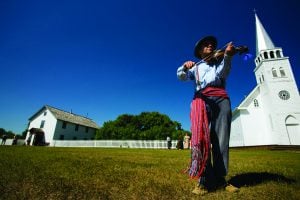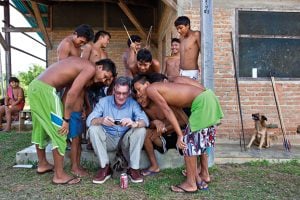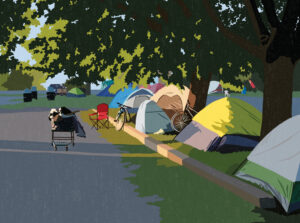
People & Culture
Kahkiihtwaam ee-pee-kiiweehtataahk: Bringing it back home again
The story of how a critically endangered Indigenous language can be saved
- 6310 words
- 26 minutes
This article is over 5 years old and may contain outdated information.
People & Culture

One moment you’re in England performing the most famous song ever written about lumberjacks, backed by a chorus of Monty Python’s faux Mounties. The next you’re really in Canada, receiving the highest honour awarded by The Royal Canadian Geographical Society.
OK, so a lot transpired between that first filming of the “Lumberjack Song” skit in 1969 and Michael Palin’s summer 2013 visit to Toronto, where he accepted the Society’s prestigious Gold Medal, which is awarded for achievements in geography. Palin (pictured above, at the event) held several hundred fans rapt with a speech at the Royal Conservatory theatre, saying he was “proud and privileged to have won the Gold Medal, and to tread in the footsteps of many great geographers.” Yet it’s hard to think of someone who’s had a greater impact on geographic literacy the world over, or with a more genuine, contagious enthusiasm for sharing and showcasing the globe’s people, cultures and environments.
With his BBC crew by his side, the former Python member turned intrepid travel- documentarian has produced nine acclaimed adventure series, spanning more than 80 countries in seven continents. In the first, Around the World in 80 Days (1989), he plays a modern-day version of Jules Verne’s Phileas Fogg. In the most recent series, Brazil (2012), he flaunts both familiar and unfamiliar sides of the world’s fifth-largest nation and growing economic powerhouse.
With accompanying books, audiobooks and photo collections, the series have been responsible for what travel agencies have called the “Palin effect” for many years. That is, when he visits a new location — even the most obscure of places — it is soon after besieged by inspired and aspiring adventurers.
“As I embarked on my travels,” said Palin in Toronto, “I realized that the only useful approach was to combine my natural curiosity and an abundant sense of wonder with real geographical knowledge. In this way you can better understand the basic questions of where we live, why we live where we live, and how we live where we live. Geography, in other words.”
Are you passionate about Canadian geography?
You can support Canadian Geographic in 3 ways:

People & Culture
The story of how a critically endangered Indigenous language can be saved

People & Culture
An exclusive Q&A with British explorer, comedian and actor Michael Palin

Places
In Banff National Park, Alberta, as in protected areas across the country, managers find it difficult to balance the desire of people to experience wilderness with an imperative to conserve it

People & Culture
For unhoused residents and those who help them, the pandemic was another wave in a rising tide of challenges